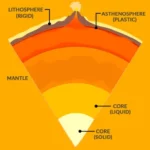Desincrustation is a deep cleansing facial treatment designed to unclog pores and remove impurities. It’s a popular pre-treatment for extractions and can significantly improve skin texture and clarity. This comprehensive guide covers everything you need to know about desincrustation, from its benefits and procedures to potential risks and aftercare.
What is Desincrustation?
Desincrustation is a specialized facial treatment that utilizes alkaline-based products, often combined with galvanic current or ultrasonic waves, to deeply cleanse pores. It targets hardened sebum (oil) and keratin (a protein) within hair follicles, breaking them down for easier removal. Think of it as a deep cleaning treatment that goes beyond what you can achieve with standard face washing. It’s especially beneficial for those with oily or congested skin or individuals prone to blackheads. By softening and loosening impurities, desincrustation preps the skin for extractions, making the process more effective and less painful. Learn more about femoral retroversion through our guide.
How Does Desincrustation Work?
Desincrustation treatments typically employ one of two main methods:
Galvanic Desincrustation
This method uses a low-level direct electrical current to enhance the deep cleansing action. The esthetician applies a negatively charged alkaline solution to your skin while you hold a positively charged electrode (inactive). The esthetician then uses a negatively charged electrode (active) on your skin. The current helps the negatively charged solution penetrate deeper into pores, breaking down sebum and keratin. The current also causes a chemical reaction called saponification, transforming the sebum into a soap-like substance that’s easily rinsed away.
Ultrasonic Desincrustation
This method utilizes high-frequency sound waves to create vibrations that help loosen and dislodge impurities from pores. It’s often used in conjunction with an alkaline solution to increase its effectiveness. While both methods achieve deep cleansing, galvanic desincrustation may be more effective for particularly stubborn blockages.
Benefits of Desincrustation
Desincrustation offers several potential benefits:
- Deep Pore Cleansing: Removes dirt, oil, and other impurities that regular cleansing might miss.
- Blackhead and Whitehead Reduction: Helps to clear out congested pores, minimizing the appearance of blackheads and whiteheads.
- Improved Skin Texture: Leads to smoother and more refined skin texture by removing the buildup of dead skin cells and sebum.
- Preparation for Extractions: Softens hardened sebum, making extractions easier, more efficient, and less painful.
- Enhanced Product Absorption: Clean pores allow for better absorption of subsequently applied skincare products, maximizing their benefits.
Who is Desincrustation Right For?
Desincrustation can be a valuable treatment for:
- Oily or Congested Skin: Helps regulate sebum production and prevent pore blockages.
- Blackhead-Prone Skin: Effectively targets and removes blackheads.
- Preparation for Extractions: Maximizes the effectiveness of extraction procedures.
Precautions and Contraindications
While desincrustation is generally safe, certain individuals should avoid this treatment:
- Sensitive Skin: This treatment can potentially cause redness or irritation. A patch test is recommended before a full treatment.
- Certain Skin Conditions: Individuals with rosacea, eczema, or other active skin conditions should consult a dermatologist before undergoing desincrustation.
- Metal Implants or Pacemakers: The electrical current used in galvanic desincrustation may interfere with these devices.
Desincrustation Gel: A Deeper Look
Desincrustation gels play a vital role in the treatment process. These gels typically contain alkaline ingredients that work to break down sebum and other impurities within the pores. Some gels also contain additional ingredients like charcoal or black seed oil, which are believed to have further cleansing and purifying properties, although more research is needed in this area.
The gel is applied to the skin before the application of galvanic or ultrasonic current. The alkaline nature of the gel, combined with the action of the current (if used), creates a synergistic effect that softens and emulsifies hardened sebum, making it easier to remove.
Iontophoresis vs. Desincrustation: What’s the Difference?
Both iontophoresis and desincrustation use galvanic current, but they serve different purposes:
- Iontophoresis: Uses a positive electrode and positively charged gel or serum to push beneficial ingredients deeper into the skin. This helps enhance product absorption and deliver targeted treatments.
- Desincrustation: Uses a negative electrode and a negatively charged alkaline solution to draw out impurities from the skin. This focuses on deep cleansing and unclogging pores.
| Feature | Iontophoresis | Desincrustation |
|---|---|---|
| Goal | Product penetration | Deep pore cleansing |
| Product | Positively charged gel/serum | Negatively charged alkaline solution |
| Electrode | Positive | Negative |
Post-Treatment Care
After a desincrustation treatment, it’s important to follow a gentle skincare routine:
- Hydration: Use a hydrating toner and moisturizer to replenish moisture.
- Sun Protection: Apply sunscreen with an SPF of 30 or higher, as skin may be temporarily more sensitive to sun exposure.
- Avoid Harsh Products:Refrain from using exfoliants or other potentially irritating products for a few days following treatment.
The Takeaway
Desincrustation can be a valuable addition to your skincare routine, particularly if you have oily, congested, or blackhead-prone skin. While more research is always welcome, current evidence suggests it can effectively deep cleanse pores and improve skin texture. It’s important to consult with a qualified esthetician or dermatologist to determine if desincrustation is the right treatment for you and to ensure the procedure is performed safely and effectively. They can assess your skin type, discuss your concerns, and recommend the best approach for achieving your skincare goals. A skincare professional can also provide guidance on how often you should have desincrustation treatments based on your individual needs. Robbie Chamberlin, known as The Renegade Esthetician, praises galvanic desincrustation for its effectiveness in loosening clogged pores. This further underscores the treatment’s potential in addressing skin congestion. By understanding the process and its potential benefits and risks, you can make informed decisions about incorporating this deep-cleansing treatment into your skincare regimen.
- Discover Long Black Pepper: Flavor & Health Benefits - April 25, 2025
- Shocking Twists: The Grownup Review: Unreliable Narration - April 25, 2025
- A Quiet Place Book vs Movie: A Deep Dive - April 25, 2025
















